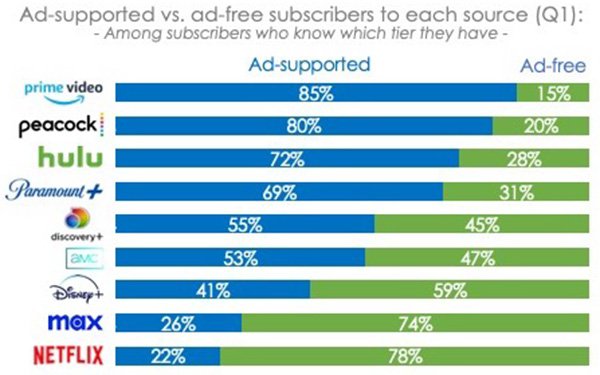Commentary
New Ad-Supported Streaming Options See Little Backlash, Study Finds
- by Wayne Friedman , Staff Writer, May 9, 2024

Blockbuster news early this year that Amazon is offering an ad-supported option for its Prime Video streaming service has dramatically boosted overall streaming video ad-supported business -- with little negative impact -- according to new data from Hub Entertainment Research.
Hub’s first-quarter 2024 TV Churn Tracker survey shows a jump in overall streaming business among consumers using only an ad-supported option -- now 18%, up from 8% in the fourth quarter of 2023.
At the same time, the percentage of those using overall ad-free streaming declined to 21% from 30% over the same period. Those using both ad-free and ad-supported services have remained virtually the same (48% versus 47%).
For many media executives, Amazon’s entry into the ad-supported option market will have dramatic results when it comes to flooding the market with new streaming advertising inventory -- which will put downward pressure on pricing.
advertisement
advertisement
Hub’s research shows that among subscribers “who know which tier they have” Prime Video now holds the leading position in terms of share going to ad-supported business: 85% of its subscribers taking the streamer’s ad-supported option, with 15% going ad-free.
Peacock is next with 80% ad-supported (vs. 20% for ad-free), followed by Hulu, at 72% for ad supported (vs. 28% for ad-free).
On the flip side, Netflix and Max have the fewest ad-supported subscribers -- at 22% and 26%, respectively.
Hub concludes from these findings that subscribers moving to ad-supported options has not resulted in any “backlash” for streaming platforms.
“There was no measurable effect on either Amazon’s subscription levels or the overall rate of SVOD [subscription video on demand] subscription. Similarly, AMC+, the other most recent entry into ad-supported streaming, saw no effect on their overall subscription rates.”
Hub’s results are based on 6,338 U.S. consumers ages 16-74, who watch at least one hour of TV per week, with interviews conducted from January-March 2024.



